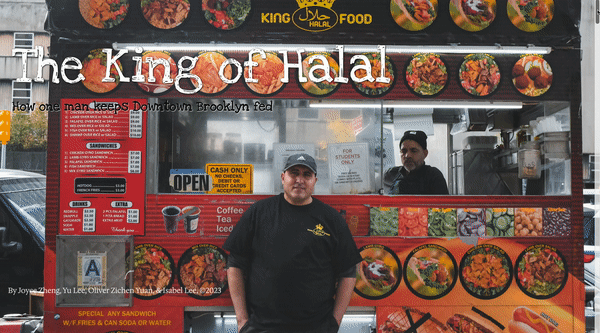The King of Halal: How one man keeps Downtown Brooklyn fed

| Project Goal
Following the strucutre of how New York Times tells stories with interactive technology, the project aims to tell the story of Ayman Zeedan, a Halal cart owner in Downtown Brooklyn through interviewing and collecting spatial elements in his life.
Following the strucutre of how New York Times tells stories with interactive technology, the project aims to tell the story of Ayman Zeedan, a Halal cart owner in Downtown Brooklyn through interviewing and collecting spatial elements in his life.
| Project Outcome
An interactive 3D website showcases the story of Ayman Zedan, recounting 20 years of his professional journey. It features a detailed 1:1 miniature model car, offering a unique and immersive perspective that allows viewers to better understand his work and the intricate details behind it.
An interactive 3D website showcases the story of Ayman Zedan, recounting 20 years of his professional journey. It features a detailed 1:1 miniature model car, offering a unique and immersive perspective that allows viewers to better understand his work and the intricate details behind it.
Exhibition
NYU ITP, Winter 2023
NYU ITP, Winter 2023
Role
Responsibel for design/part of the coding/photography, in collaboration with Yu-Ying Lee, Isabel Lee, Oliver Zichen Yuan;
Advised by Yuliya Parshina-Kottas & Or Fleisher
Responsibel for design/part of the coding/photography, in collaboration with Yu-Ying Lee, Isabel Lee, Oliver Zichen Yuan;
Advised by Yuliya Parshina-Kottas & Or Fleisher
Toolkit
React.JS | React Three Fiber | GSAP | HTML/CSS/JS | Blender | Rhino | Lightroom
React.JS | React Three Fiber | GSAP | HTML/CSS/JS | Blender | Rhino | Lightroom
Website Link ︎︎︎
Jump to 👉
02. Design
03. Development
01. Conceptual Design
01-1 Background
WHY Halal Cart?
Halal food trucks in New York City are an integral part of the city's cultural landscape, reflecting its rich diversity and providing a unique culinary experience. Halal food carts are not only an icon of the city's street food culture, they also contribute to economic development by providing entrepreneurs, often immigrants, with the opportunity to establish small businesses. Whether attracting late-night diners, tourists seeking an authentic New York experience, or locals looking for convenient and delicious street food, halal food carts have become an integral and acclaimed aspect of New York City's culinary identity.
WHY Ayman Zeedan?
The halal food truck we visited is located at the back of 370 Jay Street (where ITP locates), less than five minutes walk from the school. As a part of ITP students' daily lives, this food truck has a different meaning for us. Ayman, the owner of the food truck, was kind enough to grant us an interview, and remembered to remind us to grab a "student free" drink after ordering.
01-2 Interview
Our questions to Ayman were divided into two parts: his personal experience - why he became the owner of a halal food truck and his experience as an owner. The other part was a technical question, centered around the halal food truck, where we aimed to investigate more of the spatial details for the visual presentation.
Narrative
- How long have you been working here?
- When did you emigrate from Egypt? Why?
- Does your family live with you here in NYC?
- Where do you live? How far do you drive every day?
- Were you always in this location in brooklyn? Or have you been to other locations?
- How did you get into the halal cart industry?
- Is there a NYC Halal cart community?
- How has the city changed since you’ve started working?
- Do you enjoy this job? Any wonderful moments/downtime during these years?
- What are the policies (NY state/NYC) that you think are friendly, or not friendly to halal cart owners/workers?
Technical
- Do you own the wagon? For how long?
- Did you build the cart yourself?
- How did you organize the cart?
- How do you power the cart?
- How does licensing work?
- What is maintenance like?
02. Design
02-1 Storyboard
After interviewing with Ayman, we created the storyboard of the website based on the summary.
Problem Statement:
How might we present Ayman’s daily activity within the limited-space truck from multi-dimensions, while embedding the story from his perspective?
Based on the question, we came up with a more detailed storyboard of what we would like to present.

02-2 Process
To present the spatial concept more accurately, we decided to make a 1:1 size model based on Ayman’s cart.
Measuring ->
Measuring ->



As the model would be presented from a third-person perspective according to the story board design, we wanted to add more first-person 3D content to add the immersiveness. Therefore we decided to take some 360 degree photo from inside the cart.
 360 photo - inside the cart
360 photo - inside the cart
360 photo - Ayman being interviewed (right bottom corner)
03. Development
03-1 Low-fi Prototype

03-2 High-fi Prototype
Based on the storyboard & low-fi prototype, we came up with a high-fi design incorporating all the visual assets for us to implement through coding.
03-3 Implementation

1 - Intro

2 - Model Breakdown

3 - Narration

4 - Ending (360 Degree Photo)
The website is fully built with react.js and react three fiber.
GitHub Link ︎︎︎
︎︎︎[Prev]
Thank you for reading 🌯